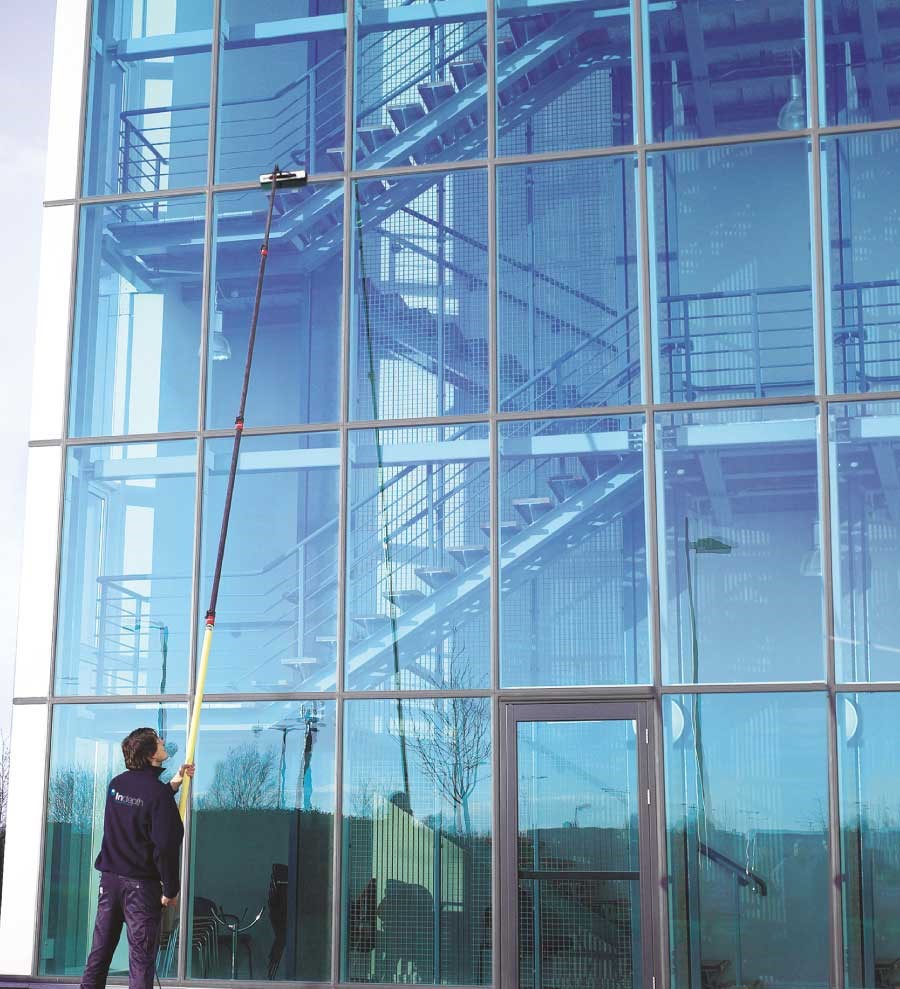
Kelly Rose
Editor

Kelly Rose
Editor
Integrating cleaning methods in the design process of tall or signature buildings could further improve safety when window cleaning at height. Darran Yates of Incredible Window Cleaning discusses how the rules can be re-written.
Even though we have seen a safety evolution relating to how we clean windows at height, there is room for improvement. There have been changes that demand more rigorous training and safety awareness, notably the Working at Height Regulations, as amended. In our own organisation we take safety very seriously and our operatives and managers are put through their paces to ensure best practice is strictly observed while working at height.
The Health and Safety Executive (HSE) prescribes a legal requirement duty of care when working at height – these are governed by the Working at Height Regulations 2005. Under these regulations, training, competency and equipment safety are covered among other considerations and the HSE lists resources for fulfilling those professional requirements.
Training people and embracing technology are key to providing a first-class long-term service and both managers and employees must share the responsibility of ensuring best practice for working at height. At Incredible Window Cleaning we give our staff the opportunity to gain a City & Guilds level 2 cleaning and support services qualification and for our managerial staff, we go beyond level 2. Furthermore, anyone who is cleaning at height must also undertake courses in self-rescue.
However, we can’t help but notice that all over our cities and towns the architectural landscape is continually changing. Thanks to ever more unique and challenging structures, we have more extreme tall buildings than ever before. Thankfully this creative architectural trend demands the skills of accomplished window cleaners, but the high demand comes at a price; the risk of possible harm to window cleaners’ safety while cleaning at height.
This begs the question of whether we need a new direction on ensuring safety practices when it comes to cleaning at height? Instead of tackling the issue after a building is constructed, why don’t we build the safety at height provisions into the design of the building from the start? If experienced window cleaners have a voice at the beginning of the design process, then architects can potentially encompass those observations into the design and make a tall building that is safer to clean.
To some this may sound far-fetched. However, the process has already begun, thanks to the HSE’s ongoing engagement with the Royal Institute of British Architects (RIBA) to improve designer risk management under Construction Design and Management (CDM) regulations, of which cleaning at height methods are a consideration.
There has been little change to the designer role in CDM 2015: there is still a duty to eliminate, reduce or control risk in design to ensure that a building can be built, maintained and used safely and without causing ill health as far as is practicable. The principal designer has a duty to coordinate health and safety in the design phase and ensure that designers discharge their duties. RIBA provides information, guidance and advice to its members on how this can be achieved.
Groups like the Cleaning Industry Liaison Forum (CILF) also collaborate with the HSE to champion better health and safety improvements in the cleaning industry to positively impact cleaning professionals across the cleaning spectrum. Its safety campaign also includes the proposal that buildings should be designed to accommodate much safer cleaning provisions at the outset.
Of course there are technical innovations that make it easier for window cleaners to reach awkward places – lighter tools, water-fed poles, lightweight rope and cradles. We use industrial rope access techniques, and have access to mobile, hydraulically operated platforms and electrically operated cradle systems. While these developments have made significant improvements in safety, the more structurally challenging our modern architecture becomes, the more challenges are faced by the professionals who have to clean them.
Observers outside of our industry may think that our methods haven’t changed much at all. Much like a swan, the majority of the activity that propels us forward happens out of sight. However, methods and techniques which work today, may not necessarily work tomorrow unless our cleaning methods adapt with the buildings. What better way to do that than integrate cleaning methodology into the building design process? It’s definitely food for thought.
One of the greatest movements for change has been forming and joining a safety conscious professional community. Collaborations like this have improved knowledge sharing and professional credibility. Improving safety is an issue we could solve through partnership and by not being poles apart.


Leonard House
308 Winwick Road
Warrington
WA2 8JE
UNITED KINGDOM
0845 605 2251